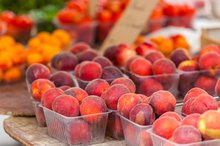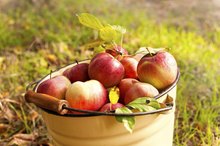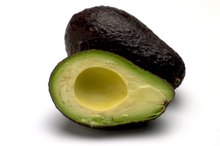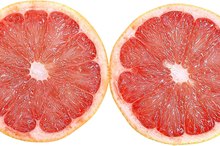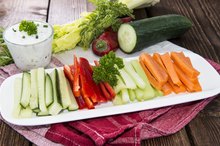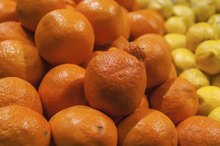Sugar Content of Vegetables & Fruits
Sugar occurs naturally in vegetables and fruits, as well as in some whole grains and dairy products. Naturally occurring sugars provide a healthy alternative to foods with added sugars, such as cakes, pastries, processed foods and refined breads and cereals. Fruits and vegetables have naturally low calorie and fat content and provide many important nutrients.
Sugar in Vegetables
Most vegetables contain some sugar. One serving of cucumber, green onions, leaf lettuce or potato contains 1 gram of sugar, according to the U.S. Food and Drug Administration. One serving of asparagus, broccoli, cauliflower, celery, green snap beans, iceberg lettuce, radishes or summer squash contains 2 grams of sugar. One serving of green cabbage or tomato contains 3 grams of sugar, a serving of bell pepper contains 4 grams of sugar and a serving of carrots or sweet corn contains 5 grams of sugar. One serving of sweet potato contains 7 grams of sugar, and one serving of onion contains 9 grams of sugar, according to the FDA.
- Most vegetables contain some sugar.
- One serving of sweet potato contains 7 grams of sugar, and one serving of onion contains 9 grams of sugar, according to the FDA.
Sugar in Fruits
Yogurt Granola Parfait Calories
Learn More
Fruits contain more sugar than vegetables. Try substituting fruit for added sugar in oatmeal, cereals and desserts. One serving of strawberries contains 8 grams of sugar, one serving of tangerine contains 9 grams of sugar, one serving of pineapple contains 10 grams of sugar and one serving of cantaloupe, grapefruit, honeydew melon or nectarine contains 11 grams of sugar, according to the FDA. Higher-sugar fruits include the peach, orange, pear, plum, cherry and banana, with 13 to 19 grams of sugar per serving, and the watermelon and grapes, with 20 grams of sugar per serving. Apples contain 25 grams of sugar per serving, according to the FDA. Lemons have only 2 grams of sugar per serving, and limes and avocados contain no sugar.
- Fruits contain more sugar than vegetables.
- Higher-sugar fruits include the peach, orange, pear, plum, cherry and banana, with 13 to 19 grams of sugar per serving, and the watermelon and grapes, with 20 grams of sugar per serving.
Avoiding Added Sugars
The majority of your sugar intake should come from naturally sweetened foods such as fruits and vegetables. The American Heart Association recommends that women limit their intake of added sugars to no more than 100 calories per day, or about 6 teaspoons of sugar. To find out if a packaged food contains added sugars, check the ingredients label. Ingredients such as dextrose, fructose, glucose, corn syrup, high-fructose corn syrup, maltose, lactose, fruit juice concentrates, malt syrup, molasses, honey, sucrose and sugar all indicate added sugars.
- The majority of your sugar intake should come from naturally sweetened foods such as fruits and vegetables.
- The American Heart Association recommends that women limit their intake of added sugars to no more than 100 calories per day, or about 6 teaspoons of sugar.
Health Benefits of Fruits and Vegetables
Are Tomatoes High in Sugar?
Learn More
Fruits and vegetables provide many nutrients, including potassium, dietary fiber, folate and vitamins A, E and C. Maintaining a healthy diet rich in fruits and vegetables reduces your risk of stroke, cardiovascular disease, type 2 diabetes and some cancers, including colon, stomach and mouth cancer. Consuming plenty of potassium-rich foods, such as fruits and vegetables, may reduce your risk of kidney stones and may help prevent bone loss. Low-calorie, high-fiber foods, such as vegetables, can help you stay full for longer, helping you control your weight and caloric intake.
Related Articles
References
- Harvard School of Public Health: Vegetables and Fruit
- Harvard School of Public Health: Increasing Daily Servings of Green Leafy Vegetables and Fruits Rich in Vitamin C Reduces Risk of Heart Disease
- USDA: What are Added Sugars?
- American Heart Association: Sugars and Carbohydrates
- The Nutrition Source, Harvard School of Public Health. Added sugar in the diet. https://www.hsph.harvard.edu/nutritionsource/carbohydrates/added-sugar-in-the-diet/
- USDA. Dietary Guidelines for Americans. Chapter 7 Carbohydrates. https://health.gov/DietaryGuidelines/dga2005/document/html/chapter7.htm.
Writer Bio
Lisa Porter began writing professionally in 2009. She writes for various websites and has a Bachelor of Arts in English literature.


